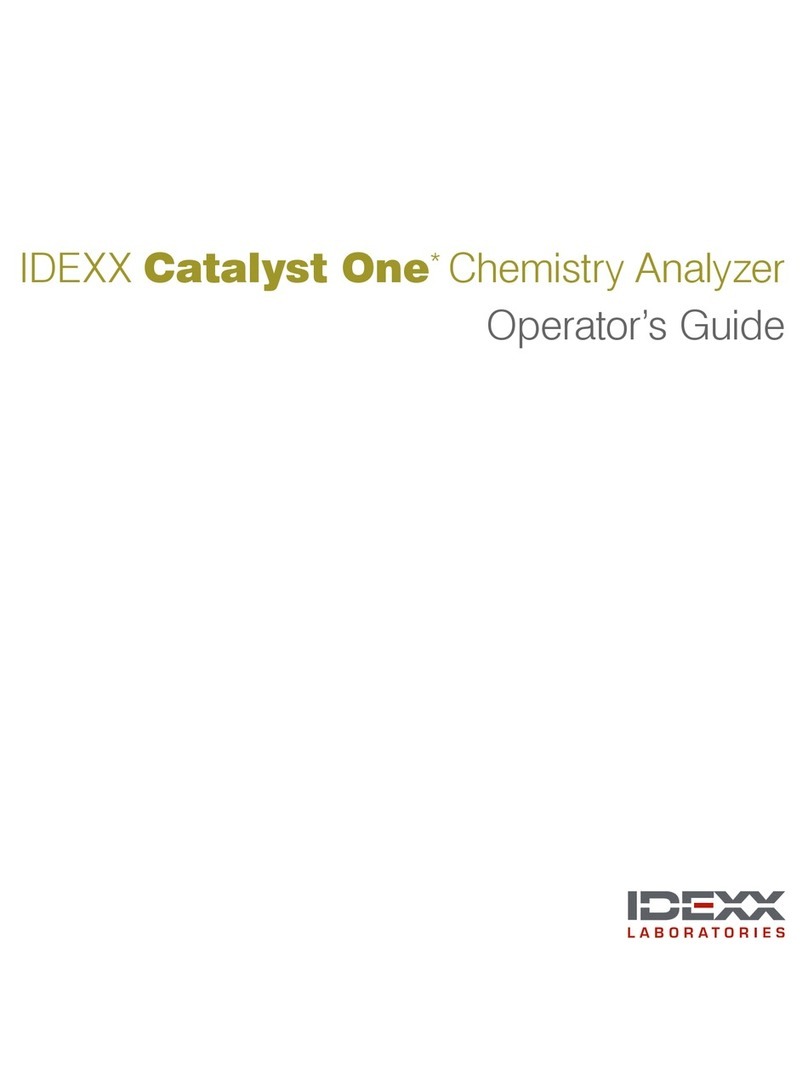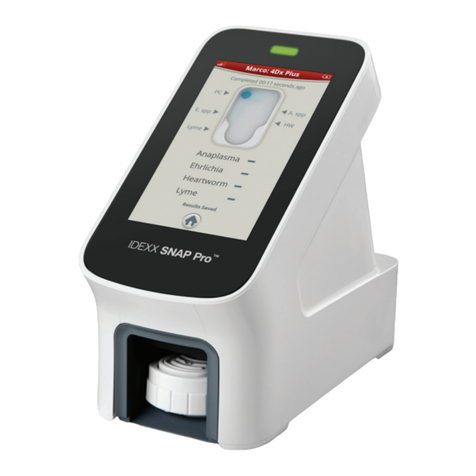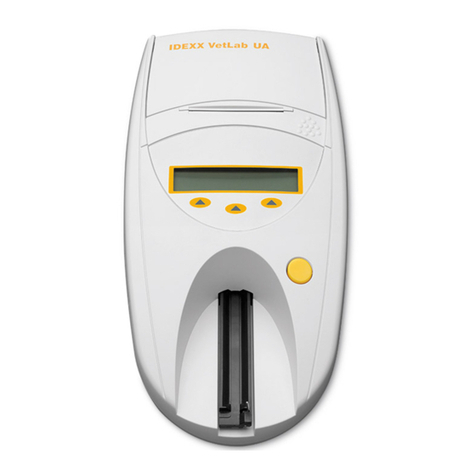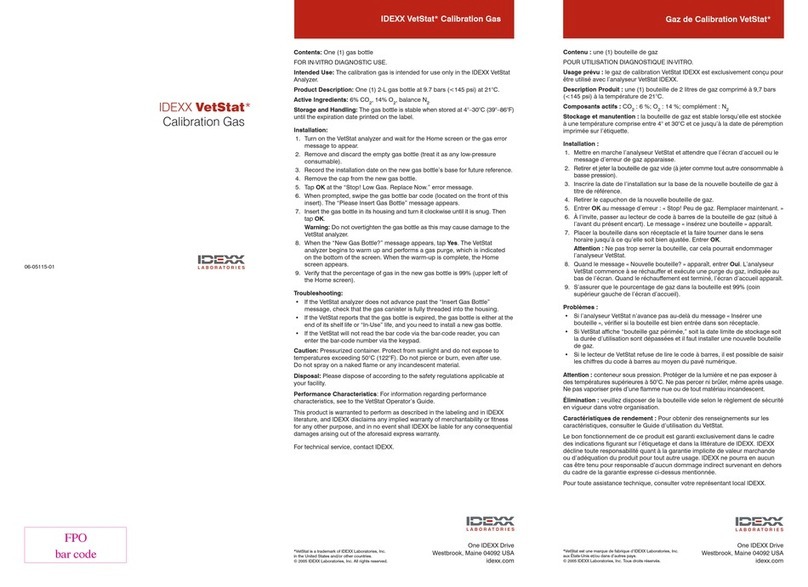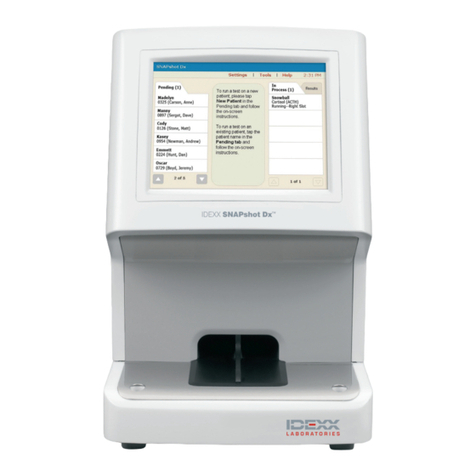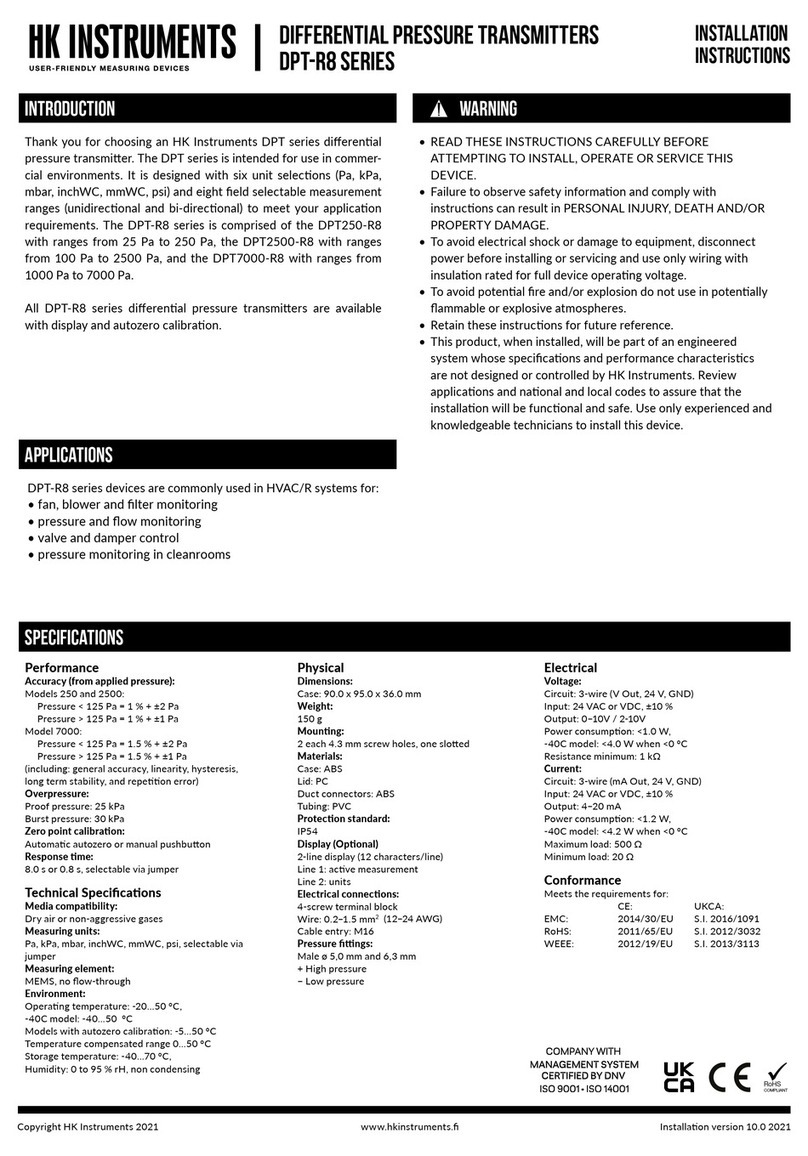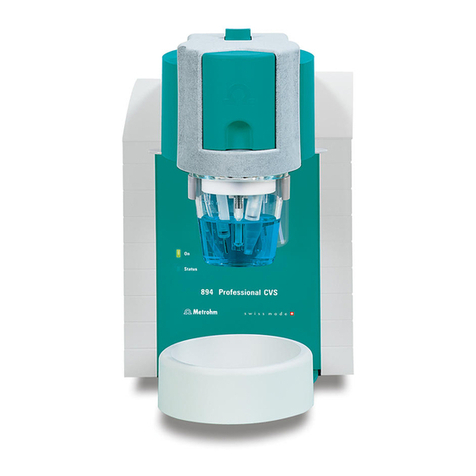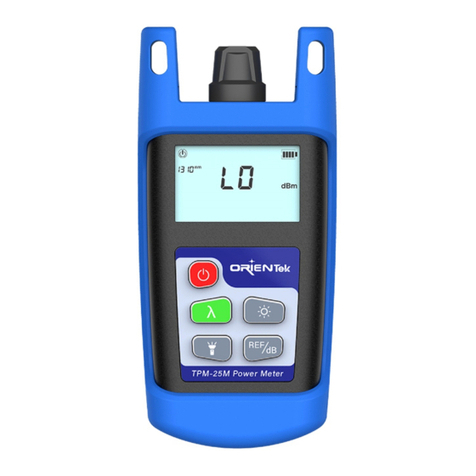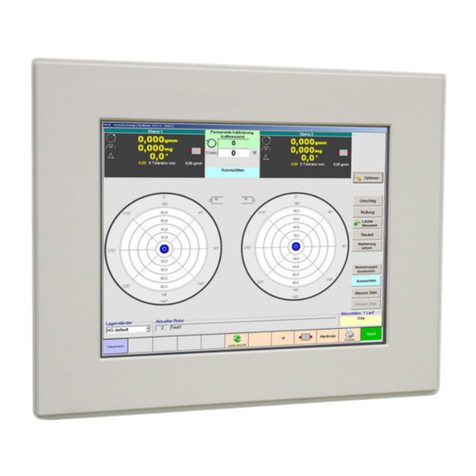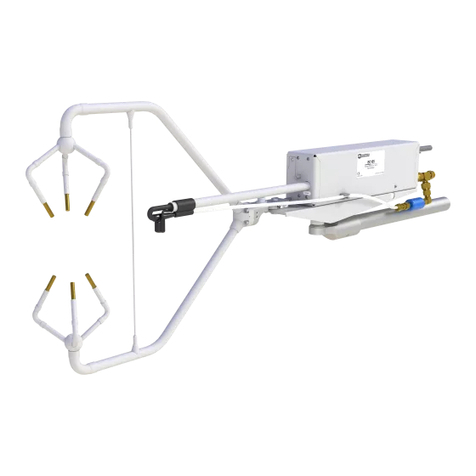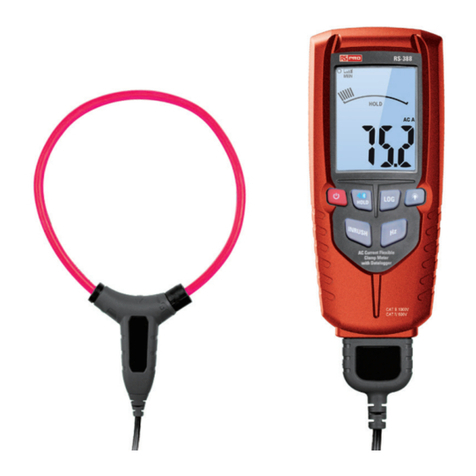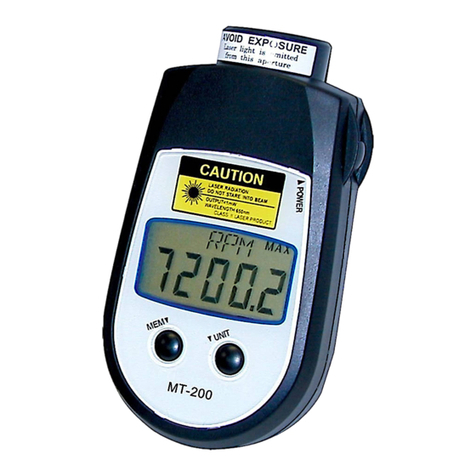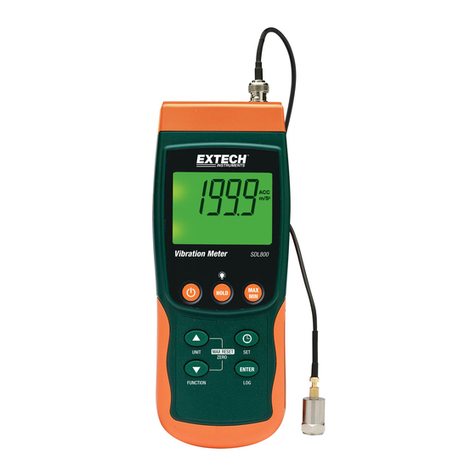Idexx SediVue Dx User manual

SediVue Dx*Urine Sediment Analyzer
User Guide

Analyzer components
Sample preparation
Urine samples can be obtained via cystocentesis, catheterization, or free catch method and should be analyzed within
30 minutes of collection (or stored in the refrigerator and returned to room temperature prior to analysis).
Sleeve lock
Centrifuge shield
Drip tray
Cartridge holder
Track
Optical stage
Optical
window
If the sample is in a container:
1. Cap the container and invert it 10 times to mix—a well-
mixed sample is essential to obtaining accurate results.
2. Immediately after inversion, use the SediVue* Pipette to
aspirate 165 µL of sample from the bottom half of the
container, ensuring there are no bubbles in the sample.
When using the pipette, follow these important guidelines:
• Crystals settle
immediately after
inversion. Aspirate from
the bottom half of the
container.
• Remove excess urine
on the tip with a lint-free
wipe.
• Hold vertically.
• ONLY depress plunger
to the first stop.
• Use only IDEXX-
supplied pipette tips.
If the sample is in a syringe:
1. In a 1 cc–5 cc syringe
containing at least 0.5 cc of
urine, draw 0.5 cc of air into
the syringe.
2. Replace the needle with a
SediVue* Syringe Tip.
3. Gently invert the syringe 10
times to mix the sample.
4. Immediately after inversion,
purge all of the air from the
syringe and inject 165 µL of
urine into the cartridge fill
port.
2
3
Analyzing a sample
1. Initiate the sample run on the IDEXX VetLab* Station.
2. Confirm the patient information, select the SediVue Dx icon, and then tap Run.
3. Follow the sample preparation guidelines on the previous page.
IMPORTANT—When injecting sample into the cartridge:
• Ensure the sample fills the cartridge window but not the overflow channel.
• Make sure the pipette tip is firmly seated into the fill port on the cartridge.
• Using light downward pressure, depress the plunger slowly to avoid air bubbles.
• Only depress plunger to the first stop.
• Lift the pipette from the fill port before you release the plunger.
4. Press the Start button on the front of the analyzer.
Waste bin
Start button
Status light
Pipetting
window
Power button
Door access
Fan filter
Stop

Running quality control on your analyzer
The purpose of quality control is to verify the integrity of your results and to verify that your analyzer is
functioning optimally. IDEXX recommends that you perform quality control once per month.
Note: Keep SediVue* QC in the refrigerator—DO NOT freeze. SediVue QC has a 12-month dating.
1. Tap the SediVue Dx icon on the IDEXX VetLab* Station Home screen.
2. Tap Quality Control, select the QC lot you are using, and then tap Run QC.
4. Gently invert the vial 10 times to ensure the cells at the bottom of the vial are completely suspended.
5. Using the SediVue* Pipette with a new pipette tip, aspirate 165 µL of L1 QC fluid and inject it into a
cartridge.
6. Press the Start button on the analyzer.
7. Repeat the above steps for the L2 QC vial.
8. Verify the results are in the target ranges and that the images are sharp and in focus.
Cleaning the analyzer
To ensure the optimal performance of your SediVue Dx* Urine Sediment Analyzer, it’s recommended that you clean the internal
components of the analyzer on a routine (monthly) or as-needed basis.
Note: You’ll need alcohol prep pads and optical tissues when performing routine and preventive maintenance. Need to order more?
Get them free at order.idexx.com (in Canada, go to idexx.ca/orderinfo).
To clean after a cartridge was overfilled or filled incorrectly
For best results, after you notice that the cartridge has been inappropriately filled, do not press the Start button as this will drag
urine into the internal components of the analyzer. Instead, follow the instructions below.
Note: Already pressed the Start button? Follow the instructions for routine monthly maintenance.
1. Open the analyzer door. Then
with gloved hands use an optical
tissue to absorb urine on top of the
cartridge.
2. Remove and dispose of the
cartridge.
3. Using a new alcohol prep pad,
clean the feed arm (dispense area),
including the front of the move arm.
Then dry the components with an
optical tissue.
4. Close the analyzer door. Once the
SediVue Dx icon has a green, “ready”
status, tap the patient icon on the
IDEXX VetLab* Station Home screen
and tap Start Run. A new cartridge
is placed in the pipetting window.
Feed arm
Move arm
Have questions? Call IDEXX Technical Support:
United States/Canada: 1-800-248-2483
Europe: idexx.eu
Distributors: [email protected]
Ireland: 353 (0)1 562 1211
United Kingdom: 44 (0)20 3788 7508
Australia: 1300 44 33 99
New Zealand: 0800 10 20 84

To clean the internal components (monthly or more frequently, if needed)
1. Tap the SediVue Dx
icon on the IDEXX
VetLab Station Home
screen, tap Turn off
SediVue Dx, and then
tap Shutdown.
4. Clean the left side of
the pusher arm 5 times
with an alcohol prep
pad (ensuring the right
edge of the track is
cleaned thoroughly),
and then dry it with an
optical tissue.
5. Press the pusher lever
to the left and repeat
step 4 on the right side
of the pusher arm.
6a. Using a new alcohol
prep pad, clean the
optical stage and
track repeatedly to
remove all debris.
Then dry with an
optical tissue.
6b. Using a new alcohol
prep pad, clean the
optical window in a
circular motion (3–4
times) and then dry
it in a circular motion
with a clean optical
tissue.
7. Remove the centrifuge
shield, waste bin and
drip tray. Then clean
them with warm water
and dry them with an
optical tissue.
8. Using a new alcohol
prep pad, clean the
move arm and then
dry it with an optical
tissue.
9. Return the waste bin,
drip tray, centrifuge
shield, and cartridge
holder to their
locations in the
analyzer.
10. Close the analyzer
door. On the IDEXX
VetLab Station Home
screen, tap the
SediVue Dx icon,
and then tap Turn on
SediVue Dx.
2. Open the analyzer
door and clean the
top and bottom of
the pipetting window
with an optical tissue
dampened with warm
water. Then dry with a
dry optical tissue.
3. Remove the cartridge
holder, clean it with an
alcohol prep pad, dry
it with an optical tissue,
and then set it aside.
Pusher arm
Pusher lever
Pusher arm
Move arm
Optical
stage
Track
Move arm
Optical
window
IMPORTANT: Do not exert excess pressure on the optical
window.

Reviewing and selecting images
By default, the first three images display alongside the results on the Records: Test Results screen. You can use the View Images
feature to add up to three additional images, change the magnification of an image, and show image tags next to identified sediment.
Note: The View Images feature will display 12 of the 70 images captured during analysis. If additional images are required to
confirm results, tap Show All (at the top of the screen) to view the remaining 58 images.
1. On the SediVue Dx tab of the Records: Test Results screen, tap View Images.
2. Tap the image that you want to view. Then you can:
Replacing the cartridge sleeve
You’ll receive a message on the IDEXX VetLab Station when the cartridge sleeve is almost empty. You
can choose to be reminded again after the next run or when the cartridge sleeve is empty.
1. Tap the SediVue Dx icon on the IDEXX VetLab Station Home screen and then tap Replace
Cartridges.
OR
Tap Replace Cartridges in the alert message.
2. Follow the on-screen instructions.
IMPORTANT: Do not remove the tape from the sleeve until it is locked into place.
3. Close the analyzer door.
4. Tap OK to confirm that the loading process is complete.
Zoom out
Zoom in
Reverse
contrast
Show/hide
image tags
View
thumbnails
Add image to
patient report
Show/hide
image toolbar
Scroll
through
images
Scroll
through
images
Permanently
add image
to record
Performing a dilution
Initiate the sample run on the IDEXX VetLab Station.
OR
If the patient has already been run once, select the patient from the
Recent Test Results list, tap Add Test,and then tap the SediVue Dx icon.
1. Tap Run Dilution.
2. Use the up/down arrows to specify the desired dilution factor (total parts).
3. Tap Run or Append Results.
4. In a test tube, mix the urine with the selected parts of 0.9% normal saline.
5. Mix the sample 10 times and then immediately inject 165 µL of the diluted
sample into the cartridge fill port.
6. Press the Start button on the analyzer. The results will be adjusted by the
dilution factor and noted that the sample was diluted.
If the dilution does not yield semiquantitative results, repeat the process using a
higher dilution factor.
Note: Diluting a urine sample may affect the pH and osmolality of the sample and
lead to changes in cellular appearance and the presence of crystals.
Enter the dilution information in the center of
the Select Instruments screen.

Understanding your results
In addition to determining results, the SediVue Dx* convolutional neural network verifies image and result quality with each run. If
the image quality cannot be verified or if confirmatory methods should be considered, a message will appear at the bottom of your
results indicating possible next steps.
Dilutions
Samples containing large quantities of overlapping cells, crystals, or debris may require manual review of the images to determine results
or a dilution to spread the sediment apart so the convolutional neural network can detect and classify the formed elements.
Preanalysis dilutions
There are times during the physical evaluation of the clarity and color of urine samples when it’s obvious that samples will be
crowded with cells, bacteria, debris, or crystals (e.g., gross hematuria). This evaluation will aid in determining if a dilution should be
considered preanalysis.
Does the color of the sample
suggest evidence of hematuria?
Red Dark red Brown
Does the clarity of the
sample suggest high
amount of cells, bacteria,
crystals, or debris?
Very
cloudy
Opaque
Consider a 1:5 dilution with 0.9% normal saline, remix the diluted sample, and rerun.
Postanalysis dilutions
When a crowded sample is run on the SediVue Dx analyzer, a message will appear, the semiquantitative results are not reported,
and you will be prompted to review the images and consider a dilution. If the images do not provide clinical insight, diluting the urine
sample will help to spread the elements apart for more accurate analysis. The dilution ratio will vary depending on the severity of the
crowding in the sample.
If the images are crowded and:
• Provide clinical insight, no dilution is needed—just add comments to the patient record.
• There is a moderate amount of cells or crystalline material, perform a 1:5 dilution with 0.9% normal saline and rerun.
• There are marked amounts of cells or crystalline material, perform a 1:10 dilution with 0.9% normal saline and rerun.
Out of focus
When the Review images to confirm results message appears, the convolutional neural network cannot verify the quality of focus
in the images. This may occur when the sample does not have enough sediment to confirm the quality of focus or if the images
are out of focus. If this message appears in several consecutive samples with sediment present, the optical window may require
cleaning.
Bacteria (suspect presence)
When the Confirm with one of the following: image review, air-dried, stained cytological preparation (“dry prep”), or urine culture
message appears, bacteria may be present in the sample. The images should be reviewed to determine if there is sufficient
evidence of bacteriuria by identifying uniformly sized structures or if the small structures are in the form of chains or doublets. If
bacteria cannot be visually confirmed in the images, prepare and review either an air-dried, stained cytological slide and/or a urine
culture due to likelihood of bacteria being found in the sample.
Bacteria possible
Bacteria possible Bacteria obvious
Bacteria (present)
When the Consider urine culture and sensitivity message appears, bacteria is present in the sample. When this occurs, consider a
culture to confirm the bacteria are viable and to provide additional evidence of bacteriuria.
© 2017 IDEXX Laboratories, Inc. All rights reserved. • 06-0035208-03
*SediVue Dx, SediVue, and IDEXX VetLab are trademarks or registered trademarks of IDEXX Laboratories, Inc. or its affiliates in the United States and/or other countries.
Other manuals for SediVue Dx
1
Table of contents
Other Idexx Measuring Instrument manuals
Popular Measuring Instrument manuals by other brands
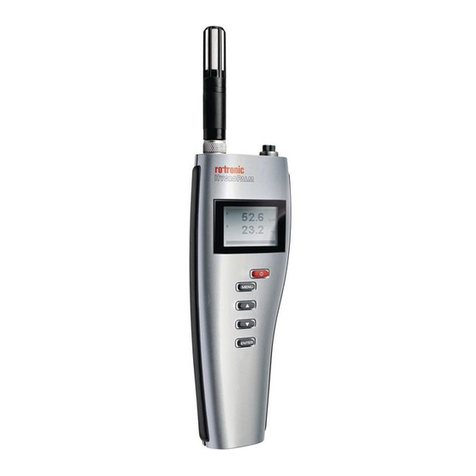
Rotronic
Rotronic HygroPalm HP23-A user guide
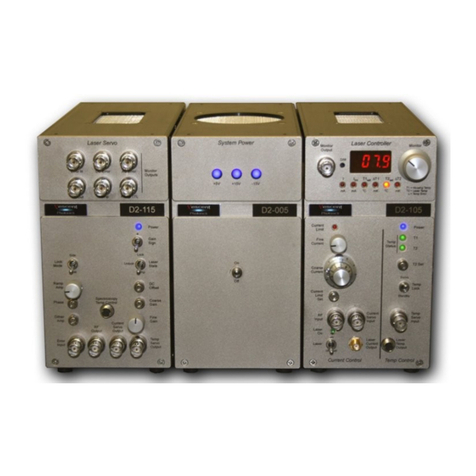
Vescent Photonics
Vescent Photonics D2 Series Quick setup guide
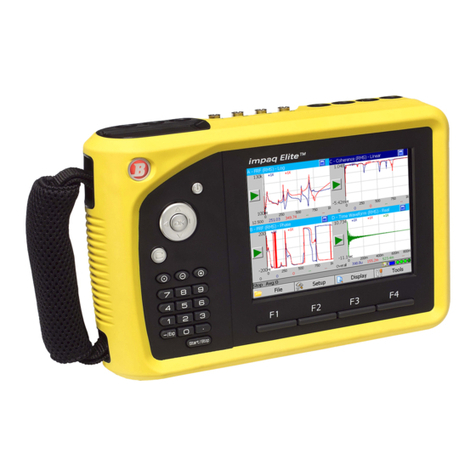
Benstone
Benstone Impaq Elite user manual

LOVATO ELECTRIC
LOVATO ELECTRIC DMED301 instruction manual
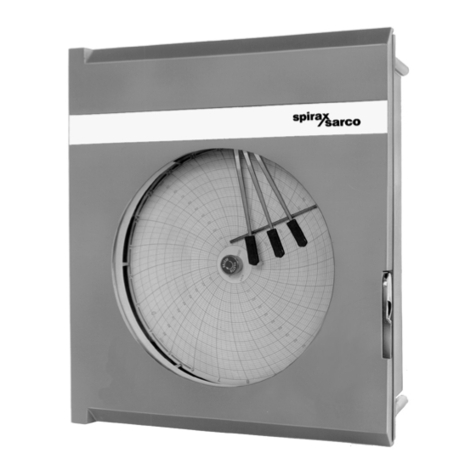
Spirax Sarco
Spirax Sarco 2000 Series Installation and maintenance instructions
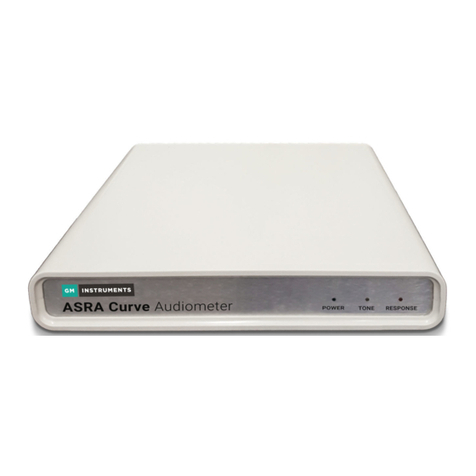
GM INSTRUMENTS
GM INSTRUMENTS ASRA user guide


